South Florida Ferns
Popular South Florida ferns for the landscape include macho, foxtail, Boston, holly, fishtail, wart, and asparagus fern.
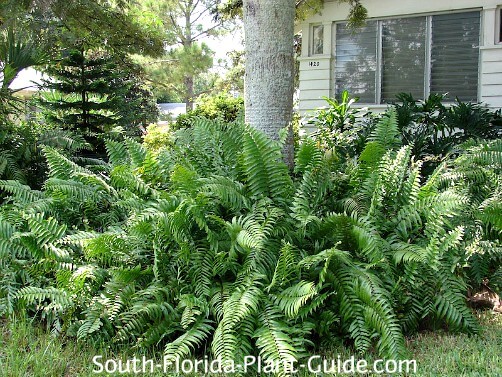
Garden ferns can work as graceful groundcovers for shade.
They're effective for filling in around taller plants - hiding the legginess of a mature cordyline (Ti plant), for instance, or surrounding a tree or palm.
Ferns can also add lush greenery to bare spots under trees.
Some South Florida ferns can take the place of foundation plants, and a few work as front-of-the-border plants.
They even make excellent accents with cut flowers from the garden, and are, of course, just stellar in hanging baskets.
There's even a gorgeous tree fern if you have plenty of room.
Ferns generally spread via underground runners...some spread all over the place, others not so much.
Each has its own personality - choose well for size and spread. Some may work for your landscape and others may not.
All take full to partial shade unless noted. All do well in Zone 10 - cold hardy ferns for Zone 9B are noted.
All South Florida ferns can be grown
as container plants and brought in during winter in Zone 9B.
Macho Fern
Nephrolepis biserrata
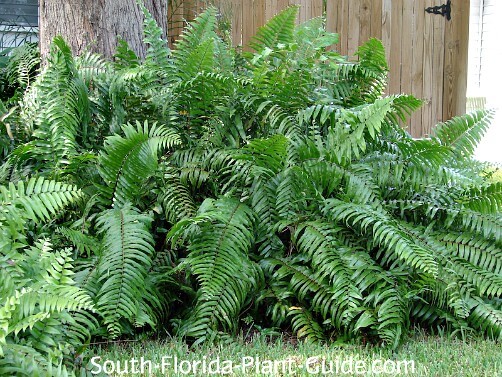
A big bold fern that makes an impressive statement. Sometimes referred to as Giant Sword Fern.
Fast grower to about 3 feet tall. Native fern. Spreads.
LANDSCAPE USES: groundcover, foundation planting, surrounding trees, camouflage for leggy plants behind it, shade garden accent
Foxtail Fern
Asparagus densiflorus 'Myers'
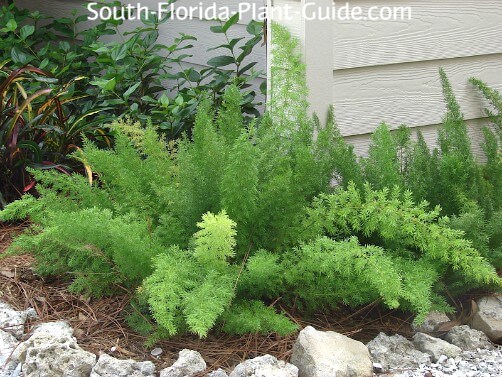
Soft tufts on a cold hardy plant. Amazingly tough in spite of its delicate good looks. Cold hardy and moderately salt-tolerant.
Grows about 2 feet tall in sun or shade. Spreads very little. Considered a deer-resistant plant.
LANDSCAPE USES: groundcover, front of the border, lining a walkway, foundation plant, garden accent
Boston Fern
Nephrolepis exaltata
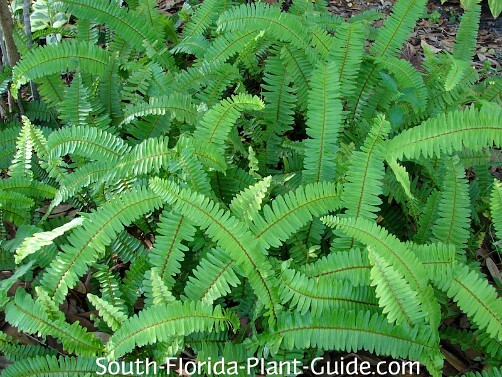
A classic among ferns. Sometimes referred to as Sword Fern, this is the one that loves growing on Canary Island date palms.
Quickly fills in an area and can be invasive so use it in a well-defined area. Cold hardy. Fast grower to 2 to 2-1/2 feet tall. Native fern. Spreads - big time...best in an edged area. Said to be deer-resistant.
LANDSCAPE USES: groundcover, filler under trees
Holly Fern
Cyrtomium falcatum 'Rochfordianum'
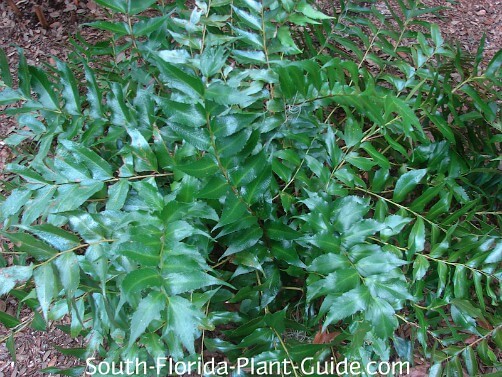
Cold tolerant beauty with glossy, deep green fronds. Slow grower to about 2 feet tall.
Usually not a lush, dense fern, more of an accent plant. For groundcover group plants fairly close together. Doesn't spread. Considered a deer-resistant plant.
LANDSCAPE USES: accent plant, front of the border, groundcover for a small area
Wart Fern
Microsorum scolopendrium
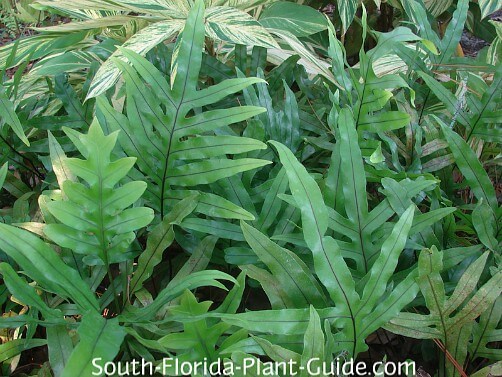
Low grower that gives a unique texture to the garden. Slow growing to an overall height less than a foot tall.
The name derives from the little bumps on the backs of the leaves. Spreads but very well mannered.
LANDSCAPE USES: groundcover
Fishtail Fern
Nephrolepis falcata
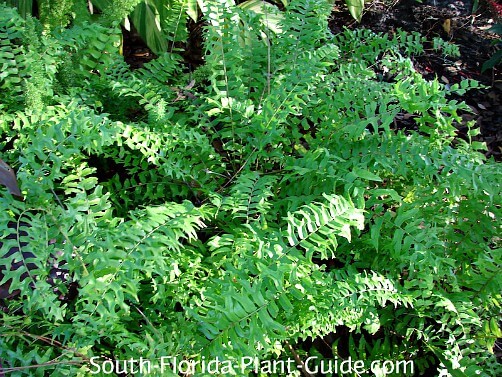
Very pretty fern with a ruffled texture. Fast grower to 2-1/2 to 3 feet tall.
Fills in an area quickly. Native fern. Spreads but can be contained.
LANDSCAPE USES: groundcover, foundation planting, lining a path or walk, surrounding trees, camouflage for leggy plants behind it, shade garden accent
Asparagus Fern
Asparagus densiflorus 'Sprengeri'
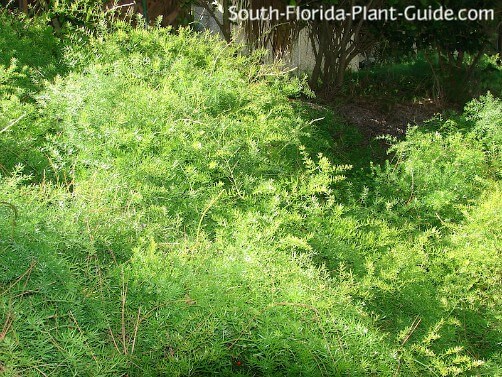
Pretty, cold hardy and salt tolerant, but also prickly, invasive and hard to get rid of. Grows to about 2 feet tall in sun or shade.
Only plant if nothing else works for hard to mow areas and embankments where soil erosion is a problem. It can be mowed or weed-whacked low to look more uniform. Spreads, very invasive. Said to be deer-resistant.
LANDSCAPE USES: groundcover for impossible areas, soil erosion control
Plant care
Add top soil to the hole when planting in very dry sandy areas.
Water regularly but don't overdo it. South Florida ferns like humidity and regular moisture but they're not wild about "wet feet."
No trimming is needed for most, other than to remove a dead frond now and then. You may at some point have to thin out a fern bed if it gets too wild-looking and overgrown.
Fertilize once or twice a year (spring and late summer) with a controlled release fertilizer.
Plant spacing
Most ferns can be placed 2 to 3 feet apart.
Come in from walks and drives 2 feet for smaller, slower ferns like wart and holly. The others should be situated 2-1/2 to 3 feet away from areas of foot or vehicle traffic.
Many South Florida ferns make wonderful container plants, especially beautiful in hanging baskets.
GOOD SNOWBIRD PLANT? YES
COMPANION PLANT SUGGESTIONS: Variegated ginger, wild coffee, dracaena and cordyline, false aralia, firespike, elephant ears, crape jasmine, variegated arboricola, and schefflera.
Other groundcovers you might like: Creeping Fig, Peperomia
- Home ›
- Groundcovers ›
- Ferns
Take a break!
The ultimate guide to low-maintenance plants
and landscaping!
An ebook by
Chase Landre
author of
South-Florida-Plant-Guide.com
Learn more!
Get a greener thumb!
Want to learn more about South Florida planting, watering, fertilizing and dealing with weeds and pests?
See our Gardening How-To section for answers!
Get instant curb appeal!
An ebook by
Chase Landre
author of
South-Florida-Plant-Guide.com
Learn how to get instant curb appeal with fast growing plants and landscaping techniques!



